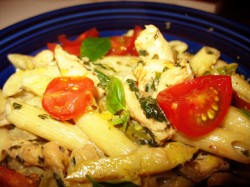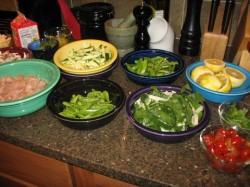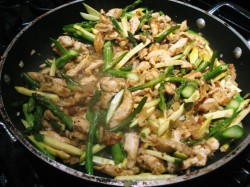When the CSA Gives You Treasures…Make Pasta Primavera!
Last Saturday was the first official CSA box from Athens Hills CSA/Green Edge Gardens, and Becky, the farmer/proprietress/all-around-awesome lady packed us a box filled with absolute treasures. Baby beets, some late asparagus, fresh shiitake mushrooms, gorgeous chard (and so sweet, too), fresh flat leaf parsley, baby carrots and the sweetest minature baby zucchini, yellow crookneck and pattypan squashes you can imagine.
I also happened to pick up at the farmers market some sugar snap peas, green beans, paper-thin skinned new potatoes, fresh onions, garlic, and some cherry tomatoes that were started in a passive solar greenhouse back in January that taste like summer’s sweetest kiss. God, those tomatoes were heavenly!
What to do with all of that bounteous beauty?
Well, I happened to have a lemon or three in my refrigerator and some bushy basil plants ready to be cut back up on my deck, so my first thoughts were towards pasta, and one of my favorite early summer pasta dishes is pasta primavera, which is essentially a mixture of springtime vegetables and greens, in some sort of sauce dressing pasta. I wrote about it last year, and I made a similar sauce this time around, and added one locally raised free-range chicken breast for a bit of protein. When I added sauteed squash, mushrooms, snap peas, asparagus, chard, onions, garlic, blanched garlic scapes and a wedding bouquet sized bunch of basil, the flavors were out of this world. I ended up dressing two pounds of pasta, and feeding six hungry adults on a very, very small budget! It was great!
The best part of it, though, was this–Morganna’s boyfriend Donny, who is, apparently a picky eater, though I would never have guesed that by the way he eats at our house, ate every one of the vegetables in the dish without complaint and liked it so much, he joined everyone else in having second helpings. Picky eater, indeed!
So what goes into pasta primavera? Well, as far as I am concerned, any spring or early summer vegetable is fair game. I didn’t add beets because they would have made some weird color issues that I am not sure I would have approved of. Besides, I am saving those baby beets to be roasted and served in a salad with chevre, mixed greens and sunflower sprouts.But, just about everything else that came home with us was used. No potatoes, because I didn’t want to add starch to the already starch-based pasta. That just seems rather redundant. But the mushrooms, scapes, asparagus, green beans, squash, and chard all did fine together. I did use quartered cherry tomatoes, a bit of finely grated lemon zest and Greek Columnar Basil leaves as garnish at the end, and they added a fresh zip to the whole affair.
As for the sauce–I did make it essentially the way I made according to last years recipe, with a few twists and changes. I used more sherry than last year, and I used the juice of one more lemon. I left out the lemon oil, however, and the turmeric from the flour coating the chicken slivers. This led to the sauce being a pale beige in color. However, I added a huge amount of basil minced–about a cup and a half of it, that I had minced in the food processor, at the very end of cooking. This changed the color and flavor of the sauce considerably. Whereas last year’s recipe was really lemony, this one was much more complex, with the sweet nuttiness of the sherry combining with the tangy lemon juice and the neutral chicken broth to make the base of the sauce, that was then made fragrant and sensual with the addition of that huge amount of basil in the end.
Oh, and I added three Thai bird chiles, cut on the bias into thin slices to the saute, to put a quiet zing in the sauce.
So–if you want to replicate this dinner, and I thiink that you should–just take the recipe from last year, and make the changes I did to the sauce, and use whatever early vegetables you like in the saute.
I have no doubt that what I made is not what could ever be called “traditional” Italian–however, I am certain that it was very flavorful, and that my family, friends and I would all have no problem making it and eating it again.
Eating this way–with the freshest produce of the seasons–retrains one’s tastebuds and even one’s way of seeing food.
I have found that because I was raised eating the vegetables, fruits, meat and eggs from my grandparents’ farm, that I am predisposed to wanting to eat this way, but Zak grew up with the grocery store mindset, and his taste has changed a great deal since we started being strongly committed to eating the bounty of our local foodshed. Morganna, too, has become very attuned to the seasonal dance of fruits and vegetables, and with each trip to the farmer’s market, she finds new treasures to be excited about. Last Saturday is was sweet and sour cherries, blueberries and raspberries. Who knows what she will cause her to dance with excitement this week?
I think that when we talk about local foods and why it is important to eat them and support local farmers, we often lose sight of the sensual aspects of eating seasonally and locally.
When we wait with joyful anticipation for the first sweet ripe tomatoes of the season, instead of settling for the plastic, flavorless imports that grace the produce department of the grocery store twelve months out of the year, we really appreciate the flavor, texture, aroma and colors of the local, real product. We become emotionally invested in our food–we become connected to it, and it stops being mere fuel, but instead becomes a physical pleasure that is undeniable in its strength.
We must not overlook the strength that the sensual pleasures of the table when it comes to bringing people together, and creating bonds of love, fellowship and friendship among people. It is fundamental to human culture to eat together, to share the bounty of food and to thus be nurtured and sustained, not only on a physical level, but also on an emotional and spiritual level.
Food stops being just something we need to keep our bodies going, and returns to being one of the strands of human culture, woven over thousands of lifetimes as we come together to share the physical gifts of the Earth.
So, when I talk about local food, I really want people to remember that eating locally isn’t just a political or economic action.
It is also a sensual choice that offers as a profound opportunity to reconnect with the Earth, with our food, and with each other.
What can be more healthy, on an individual or community level, than that?
3 Comments
RSS feed for comments on this post.
Sorry, the comment form is closed at this time.
Powered by WordPress. Graphics by Zak Kramer.
Design update by Daniel Trout.
Entries and comments feeds.






Hi,
I truly loved your article on fenugreek and also the awesome recipes that followed. Will definiteyl try them out sometime.
Lovely site. I like the passion with which you have maintained this blog. And also the level of detail in your posts. Glad to be here.
Cheers,
Sneha
Comment by Sneha — June 28, 2006 #
This sounds heavenly–I wish I was having it for dinner tonight, but I’m afraid it’s a cheese-sandwich night because of too many commitments.
I wanted to tell you I’ve discovered garlic scapes in my own garden: I’m amazed and embarrassed that I’ve had garlic growing all along and didn’t know what it was.
Comment by lucette — June 28, 2006 #
Welcome, Sneha, and thank you very much for your kind words. I hope you will keep reading and definately commment more often! (And I am very glad you liked the fenugreek recipes! Let me know how they turned out!)
Lucette–you cannot get more local than your own garden, can you? Good on you for growing garlic scapes!
Comment by Barbara — June 29, 2006 #